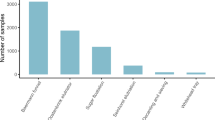Abstract
PEESENT information on the distribution and growth of micro-organisms in the soil has been obtained almost entirely by plating dilute soil suspensions on to nutrient media, the Rossi–Cholodny1 buried slide technique, Jones and Mollison's2 soil suspension preparations and similar indirect methods. Kubiena3 has developed methods of examining soil organisms in situ using reflected light, but his observations are necessarily confined to soil surfaces. So far as we are aware, the technique of preparing thin sections of soils and non-coherent rocks for microscopical examination by transmitted light has not previously been applied to the study of soil micro-organisms in their natural environment.
This is a preview of subscription content, access via your institution
Access options
Subscribe to this journal
Receive 51 print issues and online access
$199.00 per year
only $3.90 per issue
Buy this article
- Purchase on Springer Link
- Instant access to full article PDF
Prices may be subject to local taxes which are calculated during checkout
Similar content being viewed by others
References
Cholodny, N., Arch. Microbiol., 1, 620 (1930).
Jones, P. C. T., and Mollison, J. E., J. Gen. Microbiol., 2, 54 (1948).
Kubiena, W. L., “Micropedology” (Ames, 1938).
Author information
Authors and Affiliations
Rights and permissions
About this article
Cite this article
ALEXANDER, F., JACKSON, R. Examination of Soil Micro-organisms in their Natural Environment. Nature 174, 750–751 (1954). https://doi.org/10.1038/174750b0
Issue Date:
DOI: https://doi.org/10.1038/174750b0
This article is cited by
-
Techniques for the observation and isolation of soil microorganisms
The Botanical Review (1961)
-
The influence of montmorillonite on nitrogen fixation byAzotobacter
Folia Microbiologica (1959)
-
Beitrag zur Ermittlung der Pilzbesiedlung bei nat�rlichen B�den und ihrer Kennzeichnung durch ein besonderes Isolierungsverfahren
Archiv f�r Mikrobiologie (1959)
-
Sectioning of Soil
Nature (1956)
-
Die Kultivierung von Bodenpilzen auf boden�hnlichen Substraten
Archiv f�r Mikrobiologie (1955)
Comments
By submitting a comment you agree to abide by our Terms and Community Guidelines. If you find something abusive or that does not comply with our terms or guidelines please flag it as inappropriate.



